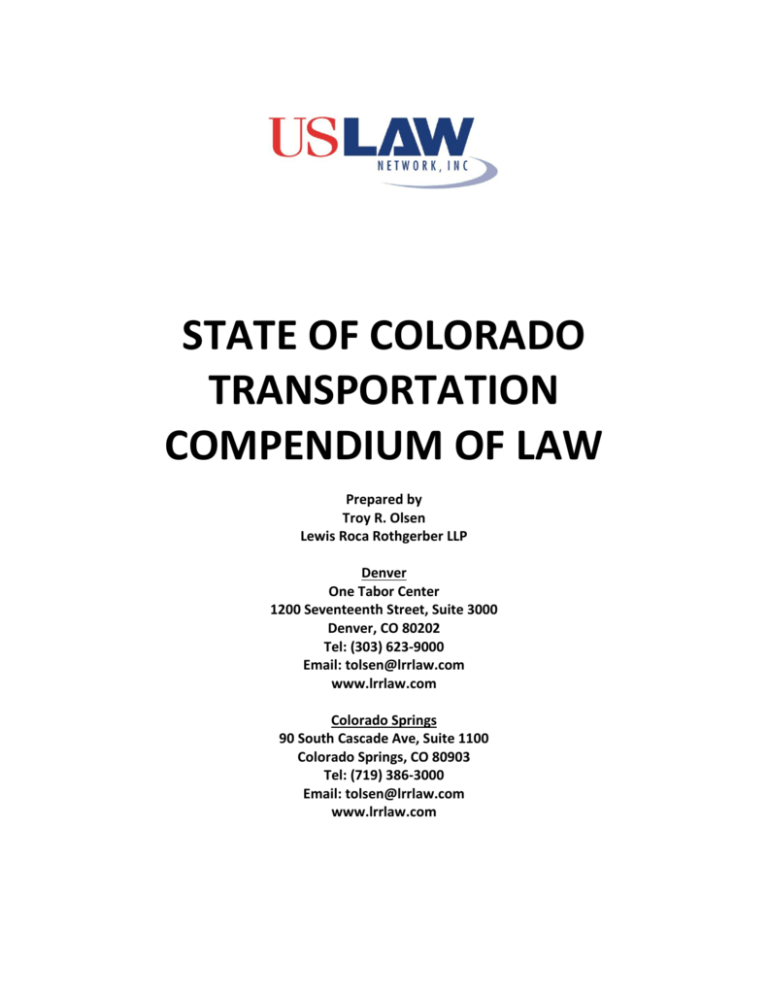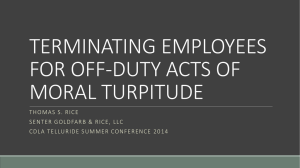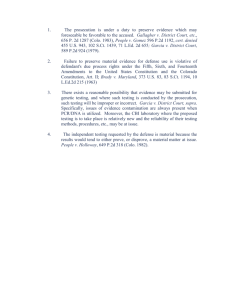Colorado - USLAW NETWORK, Inc
advertisement

STATE OF COLORADO TRANSPORTATION COMPENDIUM OF LAW Prepared by Troy R. Olsen Lewis Roca Rothgerber LLP Denver One Tabor Center 1200 Seventeenth Street, Suite 3000 Denver, CO 80202 Tel: (303) 623-9000 Email: tolsen@lrrlaw.com www.lrrlaw.com Colorado Springs 90 South Cascade Ave, Suite 1100 Colorado Springs, CO 80903 Tel: (719) 386-3000 Email: tolsen@lrrlaw.com www.lrrlaw.com A. RECOVERY ON DERIVATIVE LIABILITY CLAIMS The employer's duty to members of the public in both negligent hiring and negligent supervision cases stems from the principle that the employer receives benefits from having customers and business invitees and incurs responsibilities to them. Raleigh v. Performance Plumbing & Heating, Inc., 130 P.3d 1011, 1017 (Colo. 2006). In Colorado, there are multiple methods by which a non-employee third party can recover from an employer for an employee's actions. 1) Respondeat Superior "Under the doctrine of respondeat superior, an employer is liable for torts committed by its employee or agent while acting within the scope of employment" or the scope of the agency. Veintimilla v. Dobyanski, 975 P.2d 1122, 1123 (Colo. App. 1997). The doctrine "is based on the theory that the employee acts on behalf of the employer when the employee is within the scope of his or her employment." Raleigh v. Performance Plumbing & Heating, Inc., 130 P.3d 1011, 1019 (Colo. 2006); Henisse v. First Transit, Inc., 220 P.3d 980, 988 (Colo. App. 2009) rev'd on other grounds, 247 P.3d 577 (Colo. 2011). In order to succeed on the theory of respondeat superior, "a plaintiff must show that the employer controlled or had the right to control the actions of its purported employee." Dobyanski, 975 P.2d at 1123; see Stokes v. Denver Newspaper Agency, LLP, 159 P.3d 691, 693 (Colo. App. 2006) ("[t]he employer is liable if the employee's conduct was motivated by an intent to serve the employer's interests and connected to acts the employee was authorized to perform"). In such situations, the employer is vicariously liable for the employee's negligent acts. Raleigh, 130 P.3d at 1019. Furthermore, "[t]he vicarious liability of the employer is only secondary liability—that is, the extent of that liability is dependent on and limited by the extent to which the employee is liable." Henisse, 220 P.3d at 988 (citing Arnold v. Colo. State Hosp., 910 P.2d 104, 107 (Colo. App. 1995)). Therefore, an employer may raise any substantive defense that is available to the employee. Id. Colorado law does not recognize placard liability. However, the Interstate Commerce Commission regulations do "modify traditional common law notions of respondeat superior." Schell v. Navajo Freight Lines, Inc., 693 P.2d 382, 384 (Colo. App. 1984). "The regulations . . . eliminate the defense of independent contractor by making the owner/operator of the equipment the 'statutory employee' of the carrier." Id. "Thus, for liability purposes, an owner/operator of leased equipment is treated as an employee of the carrier during the term of the lease." Id. Example o Schell v. Navajo Freight Lines, Inc., 693 P.2d 382 (Colo. App. 1984). An interstate trucker entered into a lease with the defendant Navajo Freight Lines ("Navajo") for a tractor and flatbed trailer. Id. at 383. At a later date, the trucker ran a red 2 light and collided with another vehicle. Id. The plaintiff asserted a claim against Navajo under the theory of respondeat superior. Id. The court held that Navajo was liable for the negligent acts only if at the time of the accident, the driver was acting within the scope of his employment, and that trial court properly submitted the issue to the jury. Id. at 384-85. 2) Negligent Entrustment In the state of Colorado, to recover for the negligent entrustment of a vehicle, a plaintiff "must prove that: 1) defendant permitted its employee to use a vehicle, 2) which was under defendant's control, and 3) defendant either knew or should have known that this employee was likely to use the vehicle in such a manner as to create an unreasonable risk of harm to others." Connes v. Molalla Transp. Sys., Inc., 817 P.2d 567, 572 (Colo. App. 1991) (citing THE RESTATEMENT (SECOND) OF TORTS § 308 (1965)), affirmed, 831 P.2d 1316 (Colo. 1992). In order to prevail, the plaintiff must show that the entrusted vehicle was used in a negligent manner and that the negligent use of the vehicle caused plaintiff's injuries. Id. The Colorado Supreme Court has held that the employee does not have to be under the employer's control at the time of the accident, and that "we need look no further than the initial point of entrustment to determine whether a supplier acted negligently." Casebolt v. Cowan, 829 P.2d 352, 360 (Colo. 1992). Example o Connes v. Molalla Transp. Sys., Inc., 817 P.2d 567 (Colo. App. 1991). A long-haul driver sexually assaulted a hotel clerk. The hotel clerk asserted a claim for negligent entrustment against the employer. The court held that the doctrine of negligent entrustment should not be extended to include liability for an employer who entrusts a vehicle to an individual who has a criminal record, when the truck played no role in the assault. Id. at 572. 3) Negligent Hiring Under Colorado law, "[a]n employer is found liable for negligent hiring if, at the time of hiring, the employer had reason to believe that hiring this person would create an undue risk of harm to others." Bear Valley Church of Christ v. DeBose, 928 P.2d 1315, 1323 (Colo. 1996). The court does not inquire into why the employee was hired, but rather "whether the specific danger which ultimately manifested itself could have reasonably been foreseen at the time of hiring." Id. "[T]he scope of the employer's duty in exercising reasonable care in a hiring decision depends on the employee's anticipated degree of contact with other persons in carrying out the job for which the employee was hired." Raleigh v. Performance Plumbing & Heating, Inc., 130 P.3d 1011, 1017 (Colo. 2006). 3 Negligent hiring is distinctly different from liability under the theory of respondeat superior. "[T]he tort of negligent hiring addresses the risk created by exposing members of the public to a potentially dangerous individual, while the doctrine of respondeat superior is based on the theory that the employee is the agent or is acting for the employer." Connes v. Molalla Transp. Sys., Inc., 831 P.2d 1316, 1320-21 (Colo. 1992). Thus, it must be noted that an employer can be liable for the tort of negligent hiring even when the employee's negligent act is outside the scope of employment. Id. at 1321. However, "the tort of negligent hiring does not function as an insurance policy for all persons injured by persons an employer hires." Raleigh, 130 P.3d at 1017. The scope of the employer’s legal duty is based on the employer’s actual knowledge at the time of hiring or reason to believe that the person being hired, by reason of some attribute of character or prior conduct, would create an undue risk of harm in carrying out his or her employment responsibilities. ." Raleigh, 130 P.3d at 1017. The foreseeability of harm to the plaintiff is a prime factor in the duty analysis. Id. A court should also weigh other factors, including the social utility of the defendant's conduct, the magnitude of the burden of guarding against the harm caused to the plaintiff, the practical consequences of placing such a burden on the defendant, and any additional elements disclosed by the particular circumstances of the case. Connes v. Molalla Transp. Sys., Inc., 831 P.2d at 1320. No one factor is controlling; the question whether a duty should be imposed in a particular case is essentially one of fairness under contemporary standards -- whether reasonable persons would recognize a duty and agree that it exists. Id. Examples o Johnson v. USA Truck, Inc., No. 06-cv-00227, 2007 U.S. Dist. LEXIS 63007 (D. Colo. Aug. 27, 2007). An employer hired a driver to operate a semi-truck. Id. at *2. The driver "worked for approximately one month as a driver for a different trucking company, where he had an 'unsatisfactory' safety record and was terminated after being involved in a motor vehicle accident." Id. at *9. Under the new employer, the employee caused a subsequent accident in bad weather. Id. at *2. The United States District Court for the District of Colorado, interpreting Colorado law, held that the material facts alleged were sufficient to permit a reasonable jury to find the employer liable for negligent hiring. Id. at *10-11. o Connes v. Molalla Transp. Sys., Inc., 831 P.2d 1316 (Colo. 1992). A long-haul driver sexually assaulted a hotel clerk. The hotel clerk asserted a claim for negligent hiring against the employer. The court noted that the position did not require frequent contact with members of the public, and the driver's duties were restricted to the hauling of freight on interstate highways and involved only incidental contact with third persons. Id. at 1323. As such, the court held that the employer owed no duty beyond checking the employee's driving safety 4 record and references. Id. The act perpetrated by the employee was unforeseeable, and thus outside the scope of employer liability. Id. o Raleigh v. Performance Plumbing & Heating, Inc., 130 P.3d 1011 (Colo. 2006). An employee caused an accident when commuting home from his place of employment. Id. at 1019. Although the employee's truck was equipped with a company rack and tow gear, it was the employee's personal truck. Id. at 1014. In order for liability to attach to the employer, the employer must play a role in bringing the employee into contact with the public. Id. at 1019. Thus, the court held that the plaintiffs were not entitled to a claim of negligent hiring because they did not come into contact with the employee as a result of his employment, but rather because of the employee's commute from his employment. Id. 4) Negligent Supervision and Retention Negligent supervision and retention look beyond the employer's duty at the point of hiring and focus on the employer's liability for acts resulting from the continued employment of an employee. "A person conducting an activity through servants or other agents is subject to liability for harm resulting from his conduct if he is negligent or reckless . . . in the supervision of the activity." Destefano v. Grabrian, 763 P.2d 275, 287 (Colo. 1988) (citing RESTATEMENT (SECOND) OF AGENCY § 213 (1958)). The employer "may be negligent because he has reason to know that the servant or other agent, because of his qualities, is likely to harm others in view of the work or instrumentalities entrusted to him." RESTATEMENT (SECOND) OF AGENCY § 213 cmt.d (1958). "While the tort of negligent supervision applies to instances where the employee is acting outside his scope of employment, it does not extend to all acts undertaken by an employee that are actionable in tort." Keller v. Koca, 111 P.3d 445, 448 (Colo. 2005). Furthermore, an employer "generally does not have a duty to supervise employees in their off-duty time unless the employee is on the employer's premises or possesses the employer's property." Biel v. Alcott, 876 P.2d 60, 63 (Colo. App. 1993). Ultimately, in cases of negligent supervision “liability of the employer is predicated on the employer's antecedent ability to recognize a potential employee's attributes of character or prior conduct which would create an undue risk of harm," to others subject to the employee's contact in the course of employment. Koca, 111 P.3d at 448. Example o Johnson v. USA Truck, Inc., No. 06-cv-00227, 2007 U.S. Dist. LEXIS 63007 (D. Colo. Aug. 27, 2007). A semi-truck driver caused an accident and the plaintiff pursued the employer on a negligent supervision claim. Id. at *2. The United States District Court for the District of Colorado, interpreting Colorado law, held that a "reasonable jury could find that, given . . . [the] admittedly brief, paper-based training for driving in adverse winter weather conditions, [the employer] knew or should have known that [the driver] was ill-equipped to drive in snowy or icy 5 conditions and, therefore, posed an unreasonable risk to other drivers on Colorado roads in the dead of winter." Id. at *15. B. DEFENSES TO DERIVATIVE CLAIMS 1) Traditional Tort Defenses In claims asserting derivative liability against employers, traditional tort defenses are available to the employer. In accordance with Colo. Rev. Stat. § 13-21-111 (2011), the state of Colorado utilizes a comparative negligence scheme, rather than the traditional contributory negligence doctrine. Comparative negligence limits the liability of defendants to an amount no greater than that represented by the degree or percentage of negligence or fault attributable to them, even though some of the fault might be attributable to a nonparty. Colo. Rev. Stat § 13-21-111. Another common defense is the failure to mitigate damages. In Colorado, an injured party has a duty to take reasonable steps to minimize the resulting damage. Fair v. Red Lion Inn, 943 P.2d 431, 437 (Colo. 1997). However, a plaintiff has no duty to anticipate a tortfeasor's acts, and thus, only has a duty to mitigate damages after the injury occurs. Burt v. Beautiful Savior Lutheran Church of Broomfield, 809 P.2d 1064, 1068 (Colo. App. 1990), cert. denied (1991). Other defenses such as intervening causes and the absence of duty are applicable in Colorado law. Colorado has abolished the sudden emergency defense. Bedar v. Johnson, 292 P.3d 924 (Colo. 2013). The court held that Colorado negligence law no longer requires the sudden emergency instruction and that the instruction's potential to mislead the jury outweighs its minimal utility. Id. 2) Non-use of Safety Belt Colorado law mandates that "every driver of and every front seat passenger in a motor vehicle equipped with a safety belt system shall wear a fastened safety belt while the motor vehicle is being operated on a street or highway in this state." Colo. Rev. Stat. § 42-4-237(2) (2011). "Evidence of failure to comply with the requirement . . . shall be admissible to mitigate damages with respect to any person who was involved in a motor vehicle accident and who seeks in any subsequent litigation to recover damages for injuries resulting from the accident. Such mitigation shall be limited to awards for pain and suffering and shall not be used for limiting recovery of economic loss and medical payments." Colo. Rev. Stat. § 42-4-237(7) (2011); Wark v. McClellan, 68 P.3d 574 (Colo. App. 2003) (lack of seat belt use is admissible evidence at trial but only to reduce an award of damages for pain and suffering). 6 C. PUNITIVE DAMAGES Generally, a plaintiff can recover for punitive damages against the defendant if the defendant acted in a malicious or willful and wanton manner in causing the plaintiff's damages. CJI-Civ. 4th 5:4 (2011). In the actions discussed above, punitive damages would generally be available if the standard is met. In the case of liability based on respondeat superior, "[t]he principal cannot be held liable in exemplary damages for the act of an agent, unless it is shown that it authorized or approved the act for which exemplary damages are claimed; or, that it approved of or participated in the wrong of its agent; or, that it failed to exercise proper care in selecting its servants." Holland Furnace Co. v. Robson, 402 P.2d 628, 631 (Colo. 1965). In cases in which the defendant employer asserts comparative negligence as a defense, punitive damages are not subject to reduction by application of the comparative negligence statute. Lira v. Davis, 832 P.2d 240, 243-45 (Colo. 1992); aff'd, Lira v. Shelter Ins. Co., 913 P.2d 514 (Colo. 1996). However, punitive damages cannot exceed the amount of compensatory damages awarded after any reductions required by the comparative negligence statute. Id. This Compendium outline contains a brief overview of certain laws concerning various litigation and legal topics. The compendium provides a simple synopsis of current law and is not intended to explore lengthy analysis of legal issues. This compendium is provided for general information and educational purposes only. It does not solicit, establish, or continue an attorney-client relationship with any attorney or law firm identified as an author, editor or contributor. The contents should not be construed as legal advice or opinion. While every effort has been made to be accurate, the contents should not be relied upon in any specific factual situation. These materials are not intended to provide legal advice or to cover all laws or regulations that may be applicable to a specific factual situation. If you have matters or questions to be resolved for which legal advice may be indicated, you are encouraged to contact a lawyer authorized to practice law in the state for which you are investigating and/or seeking legal advice. 7







